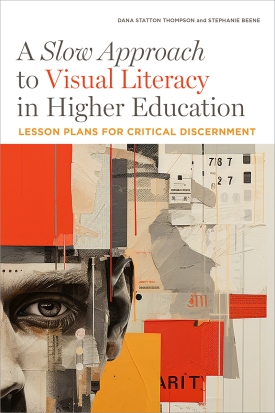
Primary tabs
You don't need to be an ALA Member to purchase from the ALA Store, but you'll be asked to create an online account/profile during the checkout to proceed. This Web Account is for both Members and non-Members.
If you are Tax-Exempt, please verify that your account is currently set up as exempt before placing your order, as our new fulfillment center will need current documentation. Learn how to verify here.
- Description
- About the authors
Centered on slow looking, slow using, and slow creating as pathways to better learning, this unique resource presents adaptable lesson plans on visual literacy for educators and librarians in higher education to use when teaching undergraduate and graduate students.
The principles of “slow librarianship”—which prioritizes reflection, collaboration, solidarity, and valuing all kinds of contributions—can also support deeper and more sustained learning and understanding. This book emphasizes the importance of attention and focus to the process of visual literacy, demonstrating how this approach supports ACRL’s Visual Literacy Competency Standards for Higher Education and the Framework for Visual Literacy in Higher Education. Library workers, educators, and instructors will discover
- dozens of flexible lesson plans for teaching visual literacy, scaffolded by competency levels: novice, intermediate, and advanced;
- ways to integrate slow looking into the classroom, emphasizing careful observation and the sustained act of looking;
- techniques for showing learners how to select images with intention, as well as carefully determine when and how to share those images;
- reasons why slow creating is essential to understanding and applying visual literacy in the twenty-first century; and
- a look at how increasing access to internet connectivity, generative artificial intelligence (AI), and new ethics for sharing and using information online will affect the future of visual literacy.
Examination copies are available for instructors who are interested in adopting this title for course use.
Dana Statton Thompson
Dana Statton Thompson is a Research and Instruction Librarian at Murray State University in Murray, Kentucky and Assistant Dean of Libraries. She is an Institute for Research Design in Librarianship scholar and served as a member of the ACRL Visual Literacy Task Force. She is active in the International Visual Literacy Association and the Art Libraries Society of North America. Her research and teaching interests focus on the intersection of visual literacy and news literacy, the integration of visual literacy instruction into higher education, and the scholarship of teaching and learning.
Stephanie Beene
Stephanie Beene is the Art, Architecture, and Planning Librarian at the University of New Mexico (UNM) in Albuquerque, New Mexico. She served as a member of the ACRL Visual Literacy Task Force and is active in the Art Libraries Society of North America, the Association of Architecture School Libraries, and the International Visual Literacy Association. Before coming to UNM, she worked at Lewis & Clark College in Portland, Oregon, as the Visual Resources and Arts Librarian. Her research interests include visual and information literacy frameworks as they relate to trust, lifelong learning, and the politics of identity.


